Financial Analysis Report: Toyota Company Performance Review
VerifiedAdded on 2020/10/04
|12
|3370
|193
Report
AI Summary
This report provides a comprehensive financial analysis of Toyota Motor Corporation, examining its performance in 2016 and 2017. The report delves into various aspects, including the company's vision and mission, long-term sources of finance, capital structure, gearing ratio, and weighted average cost of capital (WACC). It also explores short-term working capital management, efficiency ratios, and the cash conversion cycle. Furthermore, the report discusses dividend policies, profitability ratios, and a PEST and SWOT analysis of Toyota's business environment. The analysis includes interpretations of financial ratios and their implications for the company's financial health and strategic decisions. The report uses financial theories like the M&M theory and stock market theories to provide a deeper understanding of Toyota's financial position and market dynamics.
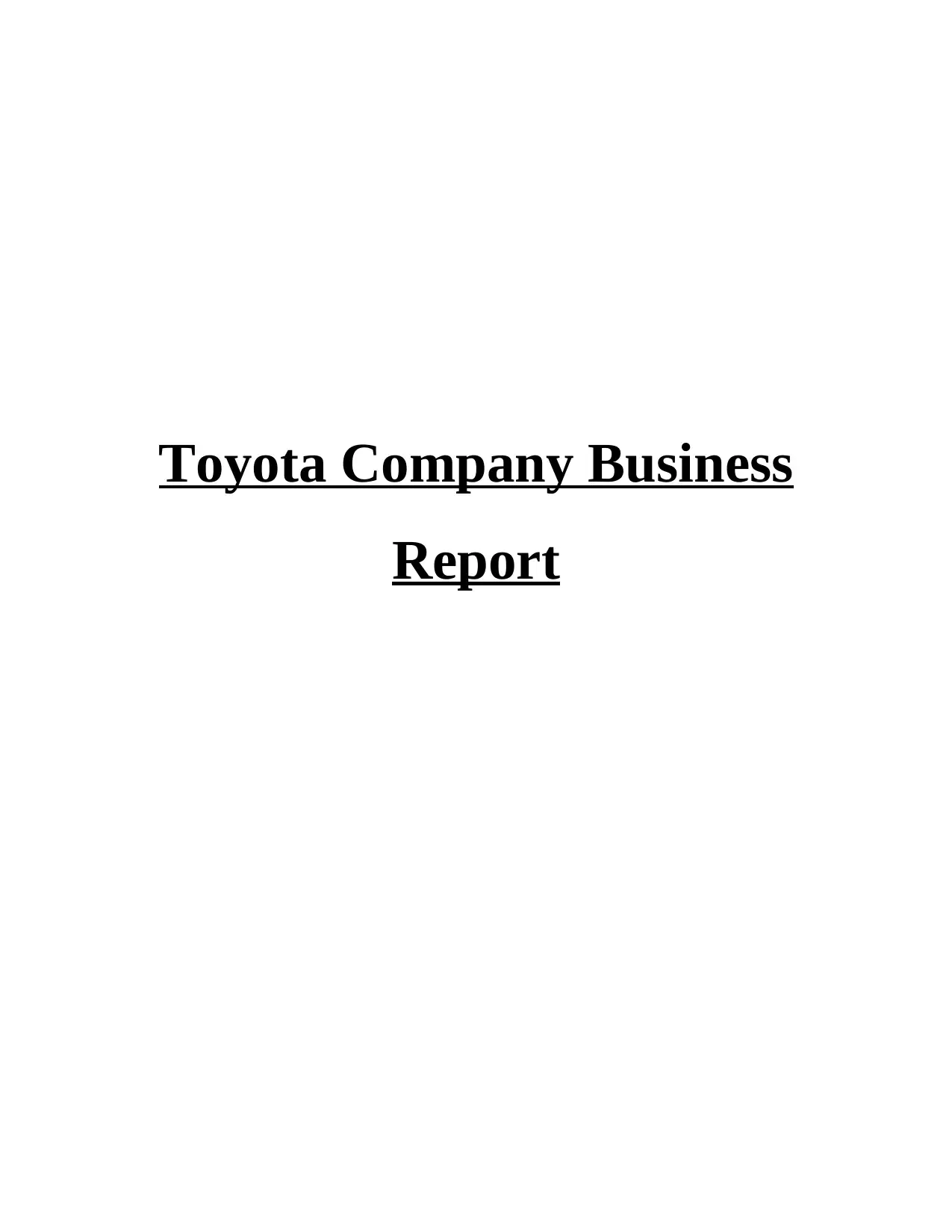
Toyota Company Business
Report
Report
Paraphrase This Document
Need a fresh take? Get an instant paraphrase of this document with our AI Paraphraser

TABLE OF CONTENTS
INTRODUCTION...........................................................................................................................1
Scope...........................................................................................................................................1
Vision & Mission........................................................................................................................1
Long terms sources of finance....................................................................................................1
Short term working capital..........................................................................................................3
Dividend policies........................................................................................................................5
Profitability Ratio........................................................................................................................5
PEST and SWOT of Toyota company........................................................................................6
CONCLUSION................................................................................................................................8
REFERENCES................................................................................................................................9
INTRODUCTION...........................................................................................................................1
Scope...........................................................................................................................................1
Vision & Mission........................................................................................................................1
Long terms sources of finance....................................................................................................1
Short term working capital..........................................................................................................3
Dividend policies........................................................................................................................5
Profitability Ratio........................................................................................................................5
PEST and SWOT of Toyota company........................................................................................6
CONCLUSION................................................................................................................................8
REFERENCES................................................................................................................................9
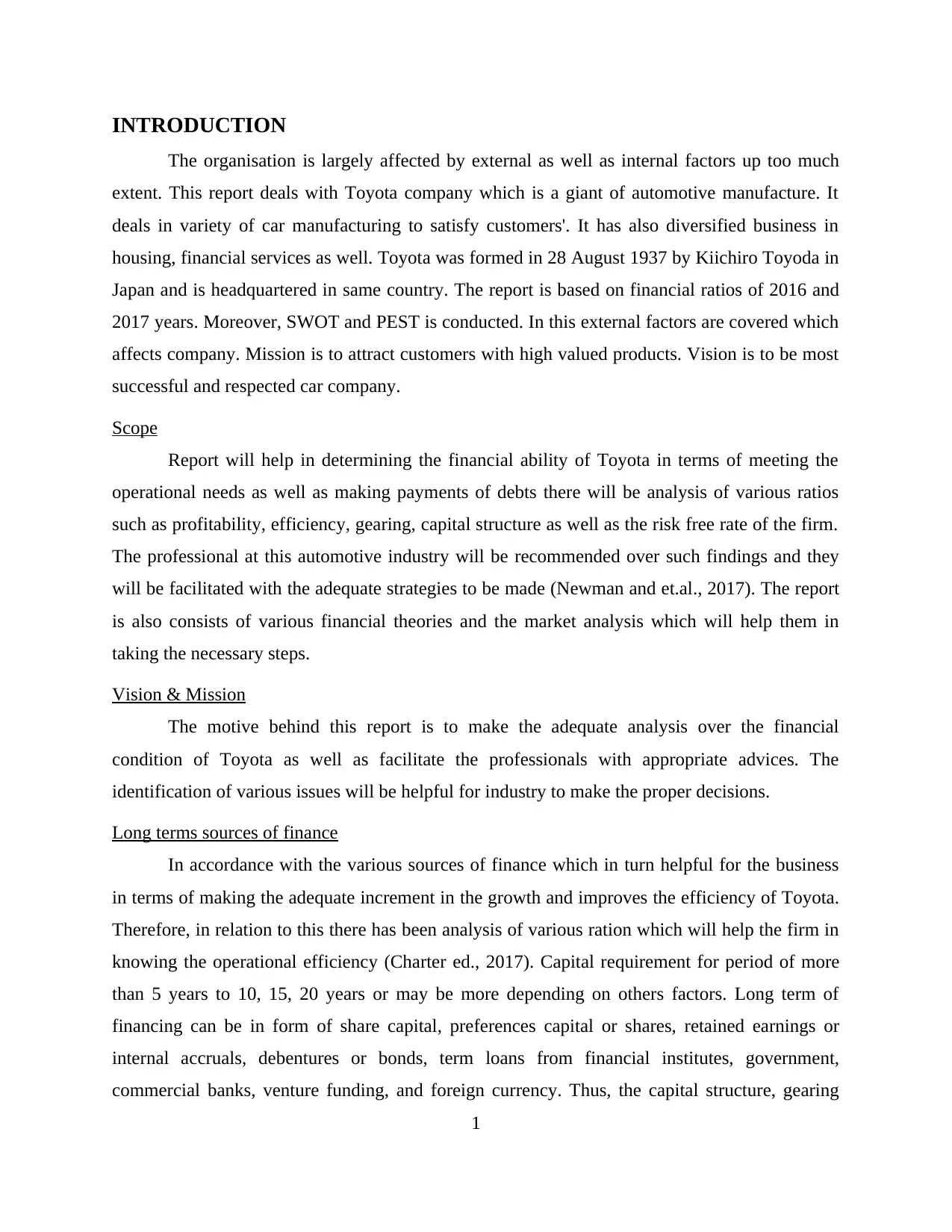
INTRODUCTION
The organisation is largely affected by external as well as internal factors up too much
extent. This report deals with Toyota company which is a giant of automotive manufacture. It
deals in variety of car manufacturing to satisfy customers'. It has also diversified business in
housing, financial services as well. Toyota was formed in 28 August 1937 by Kiichiro Toyoda in
Japan and is headquartered in same country. The report is based on financial ratios of 2016 and
2017 years. Moreover, SWOT and PEST is conducted. In this external factors are covered which
affects company. Mission is to attract customers with high valued products. Vision is to be most
successful and respected car company.
Scope
Report will help in determining the financial ability of Toyota in terms of meeting the
operational needs as well as making payments of debts there will be analysis of various ratios
such as profitability, efficiency, gearing, capital structure as well as the risk free rate of the firm.
The professional at this automotive industry will be recommended over such findings and they
will be facilitated with the adequate strategies to be made (Newman and et.al., 2017). The report
is also consists of various financial theories and the market analysis which will help them in
taking the necessary steps.
Vision & Mission
The motive behind this report is to make the adequate analysis over the financial
condition of Toyota as well as facilitate the professionals with appropriate advices. The
identification of various issues will be helpful for industry to make the proper decisions.
Long terms sources of finance
In accordance with the various sources of finance which in turn helpful for the business
in terms of making the adequate increment in the growth and improves the efficiency of Toyota.
Therefore, in relation to this there has been analysis of various ration which will help the firm in
knowing the operational efficiency (Charter ed., 2017). Capital requirement for period of more
than 5 years to 10, 15, 20 years or may be more depending on others factors. Long term of
financing can be in form of share capital, preferences capital or shares, retained earnings or
internal accruals, debentures or bonds, term loans from financial institutes, government,
commercial banks, venture funding, and foreign currency. Thus, the capital structure, gearing
1
The organisation is largely affected by external as well as internal factors up too much
extent. This report deals with Toyota company which is a giant of automotive manufacture. It
deals in variety of car manufacturing to satisfy customers'. It has also diversified business in
housing, financial services as well. Toyota was formed in 28 August 1937 by Kiichiro Toyoda in
Japan and is headquartered in same country. The report is based on financial ratios of 2016 and
2017 years. Moreover, SWOT and PEST is conducted. In this external factors are covered which
affects company. Mission is to attract customers with high valued products. Vision is to be most
successful and respected car company.
Scope
Report will help in determining the financial ability of Toyota in terms of meeting the
operational needs as well as making payments of debts there will be analysis of various ratios
such as profitability, efficiency, gearing, capital structure as well as the risk free rate of the firm.
The professional at this automotive industry will be recommended over such findings and they
will be facilitated with the adequate strategies to be made (Newman and et.al., 2017). The report
is also consists of various financial theories and the market analysis which will help them in
taking the necessary steps.
Vision & Mission
The motive behind this report is to make the adequate analysis over the financial
condition of Toyota as well as facilitate the professionals with appropriate advices. The
identification of various issues will be helpful for industry to make the proper decisions.
Long terms sources of finance
In accordance with the various sources of finance which in turn helpful for the business
in terms of making the adequate increment in the growth and improves the efficiency of Toyota.
Therefore, in relation to this there has been analysis of various ration which will help the firm in
knowing the operational efficiency (Charter ed., 2017). Capital requirement for period of more
than 5 years to 10, 15, 20 years or may be more depending on others factors. Long term of
financing can be in form of share capital, preferences capital or shares, retained earnings or
internal accruals, debentures or bonds, term loans from financial institutes, government,
commercial banks, venture funding, and foreign currency. Thus, the capital structure, gearing
1
⊘ This is a preview!⊘
Do you want full access?
Subscribe today to unlock all pages.

Trusted by 1+ million students worldwide
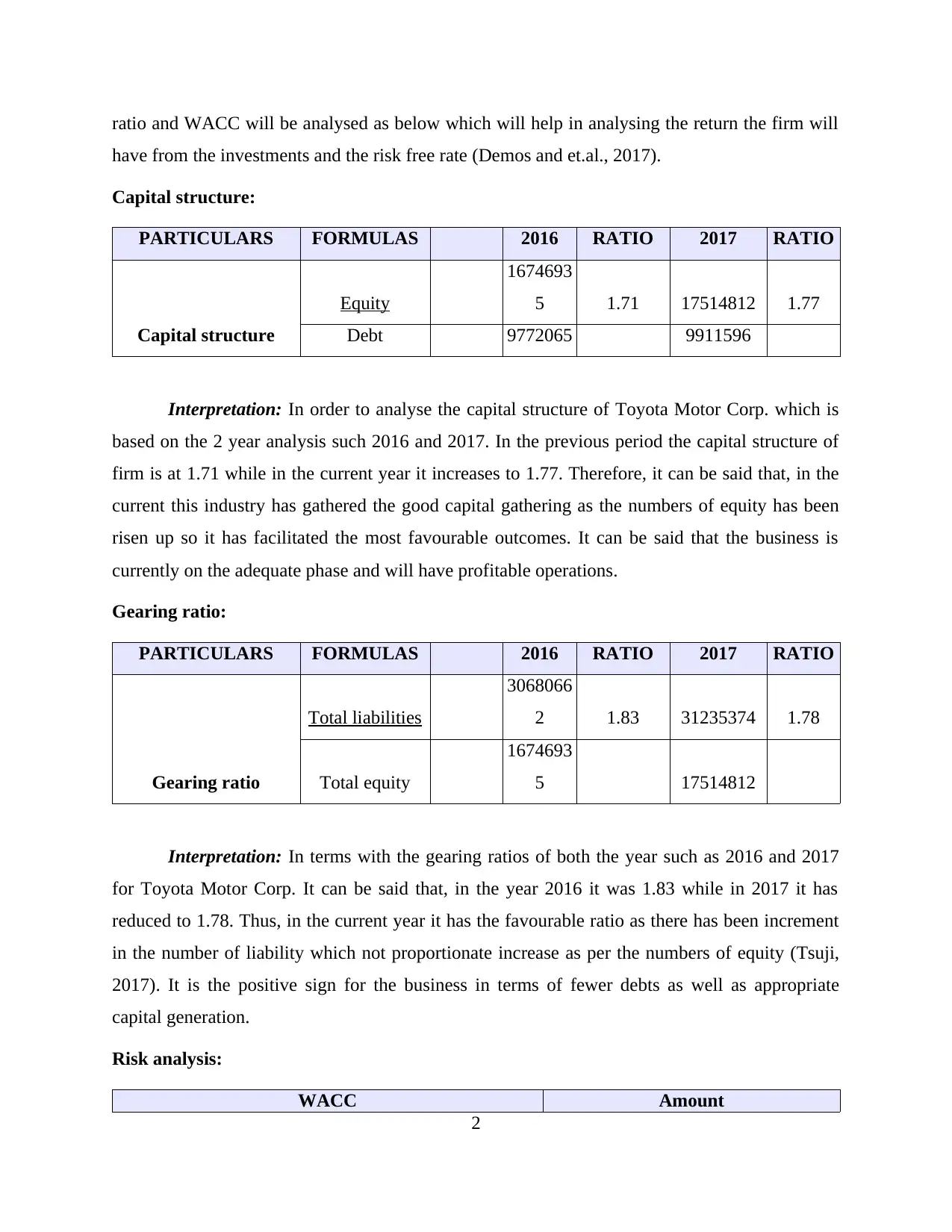
ratio and WACC will be analysed as below which will help in analysing the return the firm will
have from the investments and the risk free rate (Demos and et.al., 2017).
Capital structure:
PARTICULARS FORMULAS 2016 RATIO 2017 RATIO
Capital structure
Equity
1674693
5 1.71 17514812 1.77
Debt 9772065 9911596
Interpretation: In order to analyse the capital structure of Toyota Motor Corp. which is
based on the 2 year analysis such 2016 and 2017. In the previous period the capital structure of
firm is at 1.71 while in the current year it increases to 1.77. Therefore, it can be said that, in the
current this industry has gathered the good capital gathering as the numbers of equity has been
risen up so it has facilitated the most favourable outcomes. It can be said that the business is
currently on the adequate phase and will have profitable operations.
Gearing ratio:
PARTICULARS FORMULAS 2016 RATIO 2017 RATIO
Gearing ratio
Total liabilities
3068066
2 1.83 31235374 1.78
Total equity
1674693
5 17514812
Interpretation: In terms with the gearing ratios of both the year such as 2016 and 2017
for Toyota Motor Corp. It can be said that, in the year 2016 it was 1.83 while in 2017 it has
reduced to 1.78. Thus, in the current year it has the favourable ratio as there has been increment
in the number of liability which not proportionate increase as per the numbers of equity (Tsuji,
2017). It is the positive sign for the business in terms of fewer debts as well as appropriate
capital generation.
Risk analysis:
WACC Amount
2
have from the investments and the risk free rate (Demos and et.al., 2017).
Capital structure:
PARTICULARS FORMULAS 2016 RATIO 2017 RATIO
Capital structure
Equity
1674693
5 1.71 17514812 1.77
Debt 9772065 9911596
Interpretation: In order to analyse the capital structure of Toyota Motor Corp. which is
based on the 2 year analysis such 2016 and 2017. In the previous period the capital structure of
firm is at 1.71 while in the current year it increases to 1.77. Therefore, it can be said that, in the
current this industry has gathered the good capital gathering as the numbers of equity has been
risen up so it has facilitated the most favourable outcomes. It can be said that the business is
currently on the adequate phase and will have profitable operations.
Gearing ratio:
PARTICULARS FORMULAS 2016 RATIO 2017 RATIO
Gearing ratio
Total liabilities
3068066
2 1.83 31235374 1.78
Total equity
1674693
5 17514812
Interpretation: In terms with the gearing ratios of both the year such as 2016 and 2017
for Toyota Motor Corp. It can be said that, in the year 2016 it was 1.83 while in 2017 it has
reduced to 1.78. Thus, in the current year it has the favourable ratio as there has been increment
in the number of liability which not proportionate increase as per the numbers of equity (Tsuji,
2017). It is the positive sign for the business in terms of fewer debts as well as appropriate
capital generation.
Risk analysis:
WACC Amount
2
Paraphrase This Document
Need a fresh take? Get an instant paraphrase of this document with our AI Paraphraser
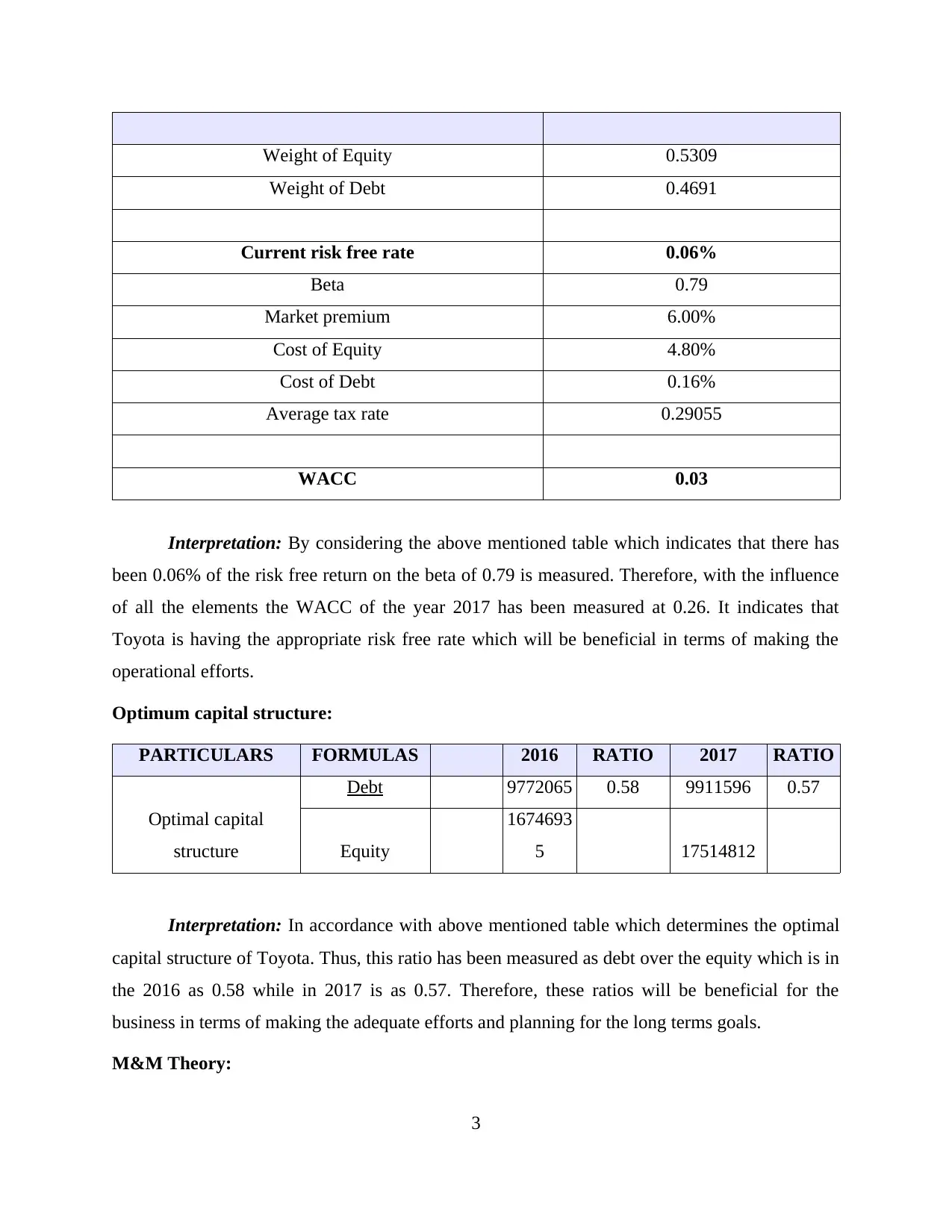
Weight of Equity 0.5309
Weight of Debt 0.4691
Current risk free rate 0.06%
Beta 0.79
Market premium 6.00%
Cost of Equity 4.80%
Cost of Debt 0.16%
Average tax rate 0.29055
WACC 0.03
Interpretation: By considering the above mentioned table which indicates that there has
been 0.06% of the risk free return on the beta of 0.79 is measured. Therefore, with the influence
of all the elements the WACC of the year 2017 has been measured at 0.26. It indicates that
Toyota is having the appropriate risk free rate which will be beneficial in terms of making the
operational efforts.
Optimum capital structure:
PARTICULARS FORMULAS 2016 RATIO 2017 RATIO
Optimal capital
structure
Debt 9772065 0.58 9911596 0.57
Equity
1674693
5 17514812
Interpretation: In accordance with above mentioned table which determines the optimal
capital structure of Toyota. Thus, this ratio has been measured as debt over the equity which is in
the 2016 as 0.58 while in 2017 is as 0.57. Therefore, these ratios will be beneficial for the
business in terms of making the adequate efforts and planning for the long terms goals.
M&M Theory:
3
Weight of Debt 0.4691
Current risk free rate 0.06%
Beta 0.79
Market premium 6.00%
Cost of Equity 4.80%
Cost of Debt 0.16%
Average tax rate 0.29055
WACC 0.03
Interpretation: By considering the above mentioned table which indicates that there has
been 0.06% of the risk free return on the beta of 0.79 is measured. Therefore, with the influence
of all the elements the WACC of the year 2017 has been measured at 0.26. It indicates that
Toyota is having the appropriate risk free rate which will be beneficial in terms of making the
operational efforts.
Optimum capital structure:
PARTICULARS FORMULAS 2016 RATIO 2017 RATIO
Optimal capital
structure
Debt 9772065 0.58 9911596 0.57
Equity
1674693
5 17514812
Interpretation: In accordance with above mentioned table which determines the optimal
capital structure of Toyota. Thus, this ratio has been measured as debt over the equity which is in
the 2016 as 0.58 while in 2017 is as 0.57. Therefore, these ratios will be beneficial for the
business in terms of making the adequate efforts and planning for the long terms goals.
M&M Theory:
3
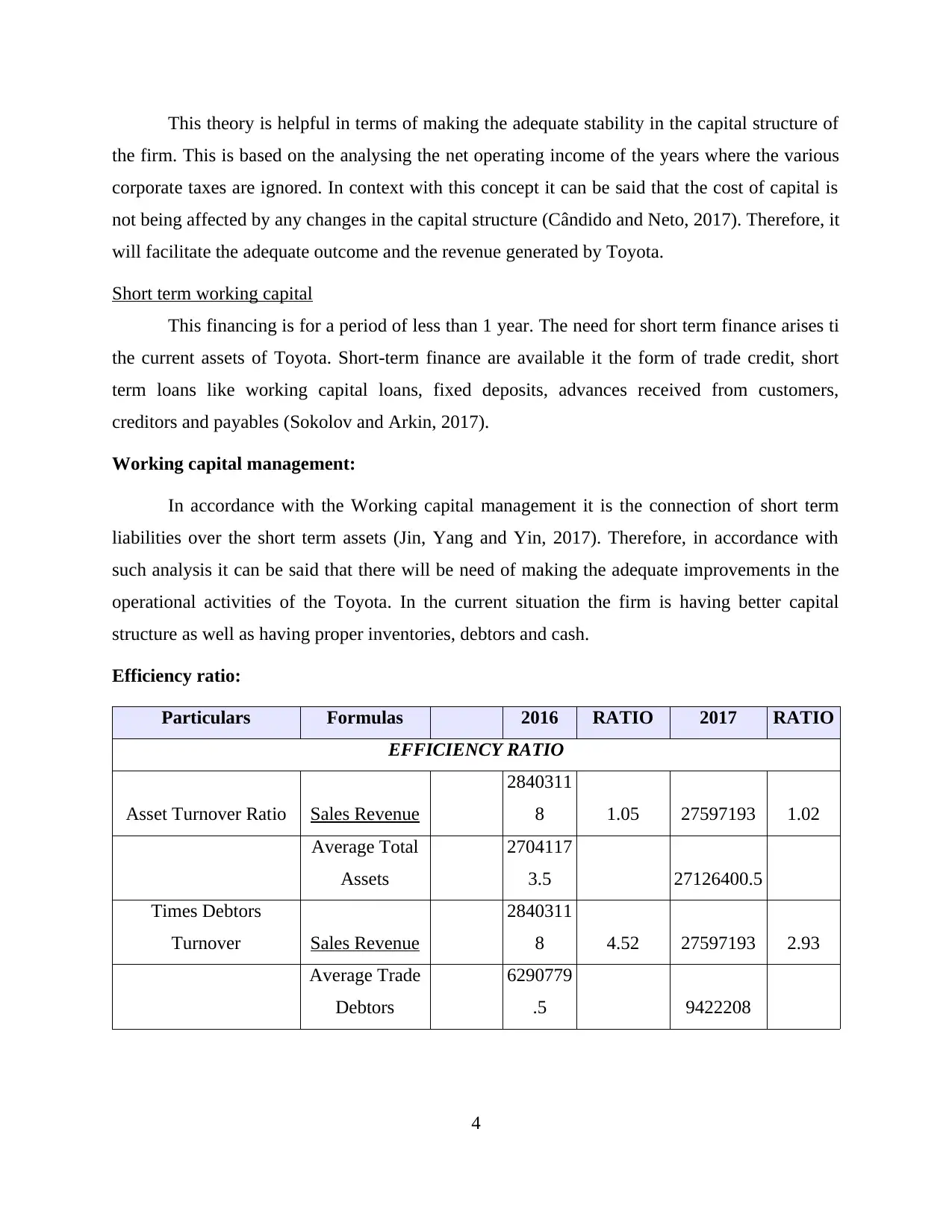
This theory is helpful in terms of making the adequate stability in the capital structure of
the firm. This is based on the analysing the net operating income of the years where the various
corporate taxes are ignored. In context with this concept it can be said that the cost of capital is
not being affected by any changes in the capital structure (Cândido and Neto, 2017). Therefore, it
will facilitate the adequate outcome and the revenue generated by Toyota.
Short term working capital
This financing is for a period of less than 1 year. The need for short term finance arises ti
the current assets of Toyota. Short-term finance are available it the form of trade credit, short
term loans like working capital loans, fixed deposits, advances received from customers,
creditors and payables (Sokolov and Arkin, 2017).
Working capital management:
In accordance with the Working capital management it is the connection of short term
liabilities over the short term assets (Jin, Yang and Yin, 2017). Therefore, in accordance with
such analysis it can be said that there will be need of making the adequate improvements in the
operational activities of the Toyota. In the current situation the firm is having better capital
structure as well as having proper inventories, debtors and cash.
Efficiency ratio:
Particulars Formulas 2016 RATIO 2017 RATIO
EFFICIENCY RATIO
Asset Turnover Ratio Sales Revenue
2840311
8 1.05 27597193 1.02
Average Total
Assets
2704117
3.5 27126400.5
Times Debtors
Turnover Sales Revenue
2840311
8 4.52 27597193 2.93
Average Trade
Debtors
6290779
.5 9422208
4
the firm. This is based on the analysing the net operating income of the years where the various
corporate taxes are ignored. In context with this concept it can be said that the cost of capital is
not being affected by any changes in the capital structure (Cândido and Neto, 2017). Therefore, it
will facilitate the adequate outcome and the revenue generated by Toyota.
Short term working capital
This financing is for a period of less than 1 year. The need for short term finance arises ti
the current assets of Toyota. Short-term finance are available it the form of trade credit, short
term loans like working capital loans, fixed deposits, advances received from customers,
creditors and payables (Sokolov and Arkin, 2017).
Working capital management:
In accordance with the Working capital management it is the connection of short term
liabilities over the short term assets (Jin, Yang and Yin, 2017). Therefore, in accordance with
such analysis it can be said that there will be need of making the adequate improvements in the
operational activities of the Toyota. In the current situation the firm is having better capital
structure as well as having proper inventories, debtors and cash.
Efficiency ratio:
Particulars Formulas 2016 RATIO 2017 RATIO
EFFICIENCY RATIO
Asset Turnover Ratio Sales Revenue
2840311
8 1.05 27597193 1.02
Average Total
Assets
2704117
3.5 27126400.5
Times Debtors
Turnover Sales Revenue
2840311
8 4.52 27597193 2.93
Average Trade
Debtors
6290779
.5 9422208
4
⊘ This is a preview!⊘
Do you want full access?
Subscribe today to unlock all pages.

Trusted by 1+ million students worldwide
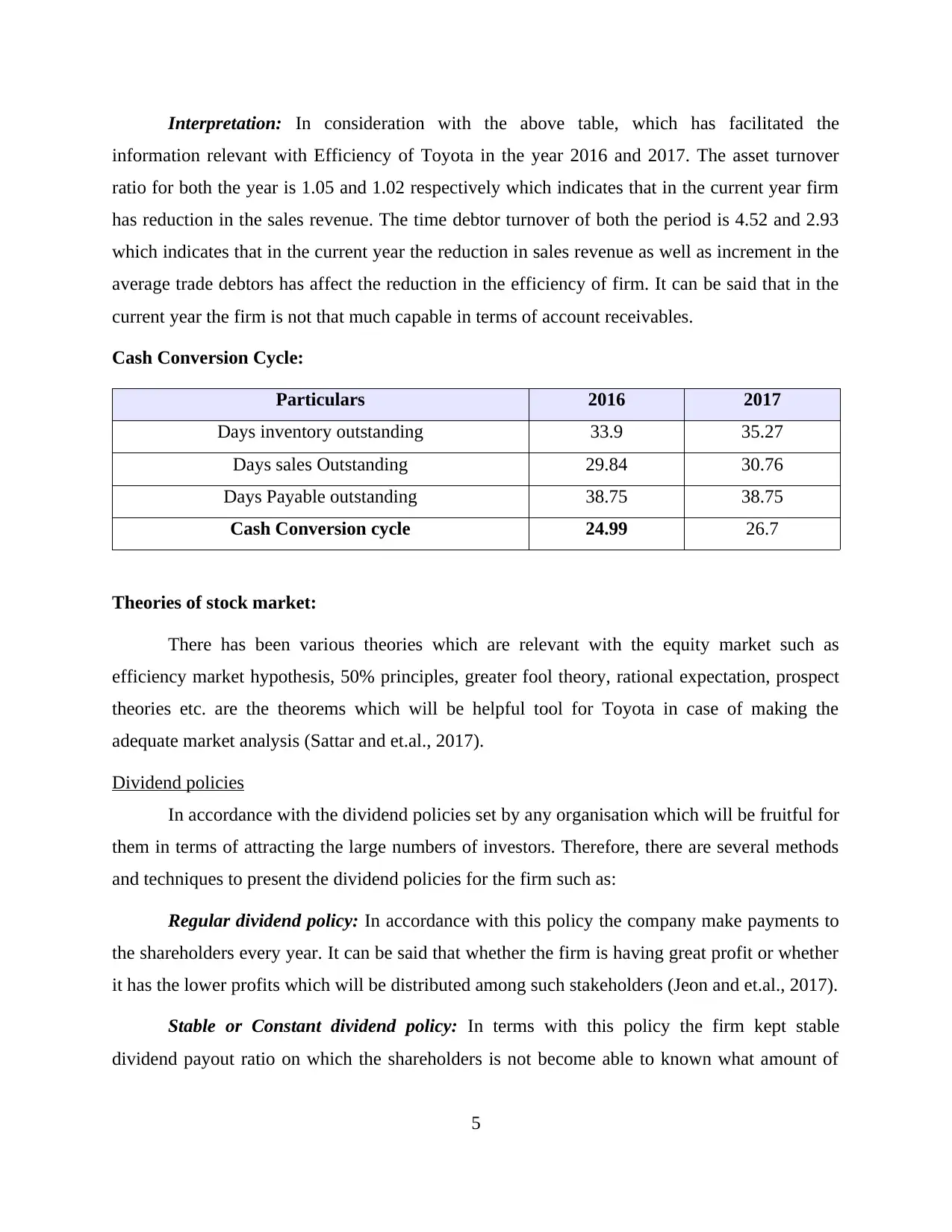
Interpretation: In consideration with the above table, which has facilitated the
information relevant with Efficiency of Toyota in the year 2016 and 2017. The asset turnover
ratio for both the year is 1.05 and 1.02 respectively which indicates that in the current year firm
has reduction in the sales revenue. The time debtor turnover of both the period is 4.52 and 2.93
which indicates that in the current year the reduction in sales revenue as well as increment in the
average trade debtors has affect the reduction in the efficiency of firm. It can be said that in the
current year the firm is not that much capable in terms of account receivables.
Cash Conversion Cycle:
Particulars 2016 2017
Days inventory outstanding 33.9 35.27
Days sales Outstanding 29.84 30.76
Days Payable outstanding 38.75 38.75
Cash Conversion cycle 24.99 26.7
Theories of stock market:
There has been various theories which are relevant with the equity market such as
efficiency market hypothesis, 50% principles, greater fool theory, rational expectation, prospect
theories etc. are the theorems which will be helpful tool for Toyota in case of making the
adequate market analysis (Sattar and et.al., 2017).
Dividend policies
In accordance with the dividend policies set by any organisation which will be fruitful for
them in terms of attracting the large numbers of investors. Therefore, there are several methods
and techniques to present the dividend policies for the firm such as:
Regular dividend policy: In accordance with this policy the company make payments to
the shareholders every year. It can be said that whether the firm is having great profit or whether
it has the lower profits which will be distributed among such stakeholders (Jeon and et.al., 2017).
Stable or Constant dividend policy: In terms with this policy the firm kept stable
dividend payout ratio on which the shareholders is not become able to known what amount of
5
information relevant with Efficiency of Toyota in the year 2016 and 2017. The asset turnover
ratio for both the year is 1.05 and 1.02 respectively which indicates that in the current year firm
has reduction in the sales revenue. The time debtor turnover of both the period is 4.52 and 2.93
which indicates that in the current year the reduction in sales revenue as well as increment in the
average trade debtors has affect the reduction in the efficiency of firm. It can be said that in the
current year the firm is not that much capable in terms of account receivables.
Cash Conversion Cycle:
Particulars 2016 2017
Days inventory outstanding 33.9 35.27
Days sales Outstanding 29.84 30.76
Days Payable outstanding 38.75 38.75
Cash Conversion cycle 24.99 26.7
Theories of stock market:
There has been various theories which are relevant with the equity market such as
efficiency market hypothesis, 50% principles, greater fool theory, rational expectation, prospect
theories etc. are the theorems which will be helpful tool for Toyota in case of making the
adequate market analysis (Sattar and et.al., 2017).
Dividend policies
In accordance with the dividend policies set by any organisation which will be fruitful for
them in terms of attracting the large numbers of investors. Therefore, there are several methods
and techniques to present the dividend policies for the firm such as:
Regular dividend policy: In accordance with this policy the company make payments to
the shareholders every year. It can be said that whether the firm is having great profit or whether
it has the lower profits which will be distributed among such stakeholders (Jeon and et.al., 2017).
Stable or Constant dividend policy: In terms with this policy the firm kept stable
dividend payout ratio on which the shareholders is not become able to known what amount of
5
Paraphrase This Document
Need a fresh take? Get an instant paraphrase of this document with our AI Paraphraser
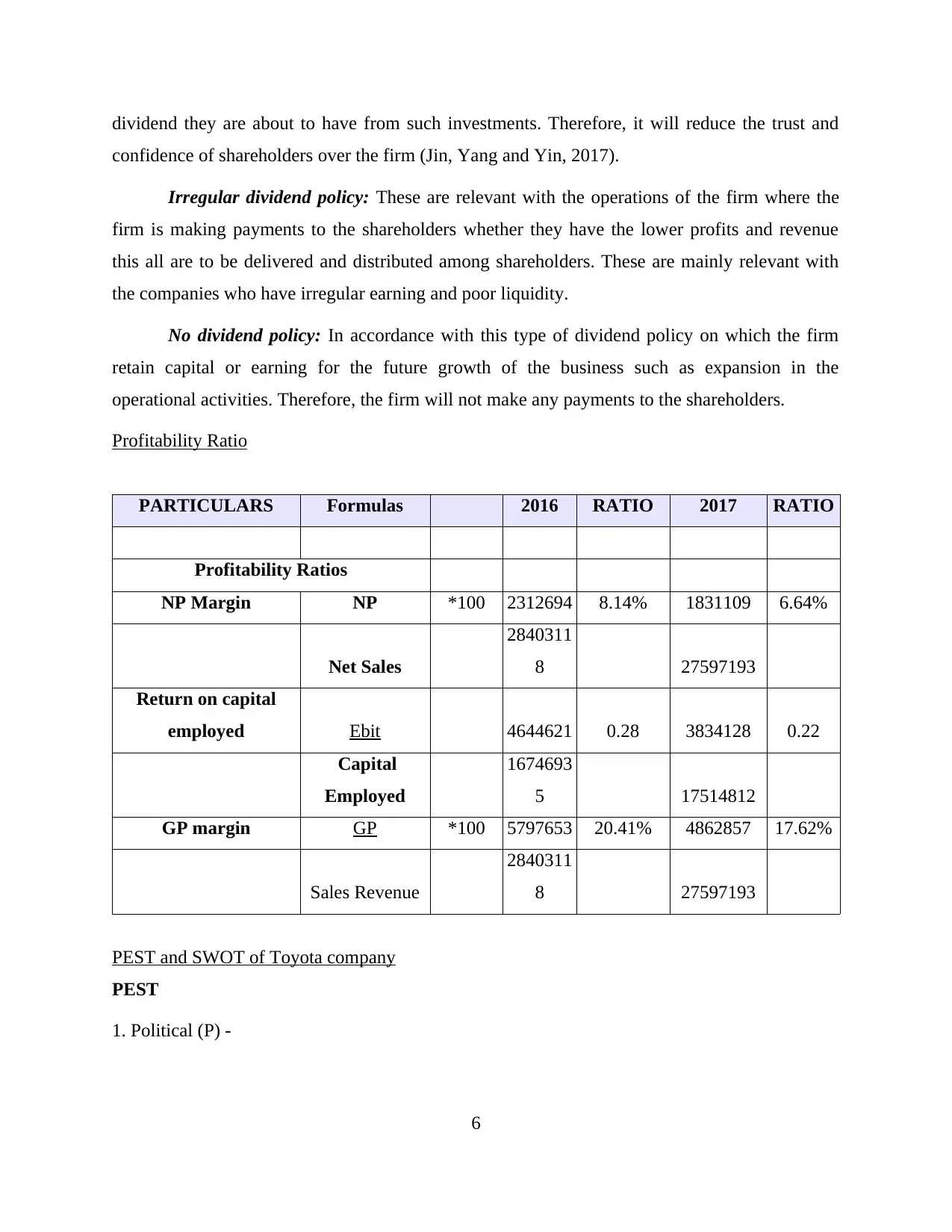
dividend they are about to have from such investments. Therefore, it will reduce the trust and
confidence of shareholders over the firm (Jin, Yang and Yin, 2017).
Irregular dividend policy: These are relevant with the operations of the firm where the
firm is making payments to the shareholders whether they have the lower profits and revenue
this all are to be delivered and distributed among shareholders. These are mainly relevant with
the companies who have irregular earning and poor liquidity.
No dividend policy: In accordance with this type of dividend policy on which the firm
retain capital or earning for the future growth of the business such as expansion in the
operational activities. Therefore, the firm will not make any payments to the shareholders.
Profitability Ratio
PARTICULARS Formulas 2016 RATIO 2017 RATIO
Profitability Ratios
NP Margin NP *100 2312694 8.14% 1831109 6.64%
Net Sales
2840311
8 27597193
Return on capital
employed Ebit 4644621 0.28 3834128 0.22
Capital
Employed
1674693
5 17514812
GP margin GP *100 5797653 20.41% 4862857 17.62%
Sales Revenue
2840311
8 27597193
PEST and SWOT of Toyota company
PEST
1. Political (P) -
6
confidence of shareholders over the firm (Jin, Yang and Yin, 2017).
Irregular dividend policy: These are relevant with the operations of the firm where the
firm is making payments to the shareholders whether they have the lower profits and revenue
this all are to be delivered and distributed among shareholders. These are mainly relevant with
the companies who have irregular earning and poor liquidity.
No dividend policy: In accordance with this type of dividend policy on which the firm
retain capital or earning for the future growth of the business such as expansion in the
operational activities. Therefore, the firm will not make any payments to the shareholders.
Profitability Ratio
PARTICULARS Formulas 2016 RATIO 2017 RATIO
Profitability Ratios
NP Margin NP *100 2312694 8.14% 1831109 6.64%
Net Sales
2840311
8 27597193
Return on capital
employed Ebit 4644621 0.28 3834128 0.22
Capital
Employed
1674693
5 17514812
GP margin GP *100 5797653 20.41% 4862857 17.62%
Sales Revenue
2840311
8 27597193
PEST and SWOT of Toyota company
PEST
1. Political (P) -
6
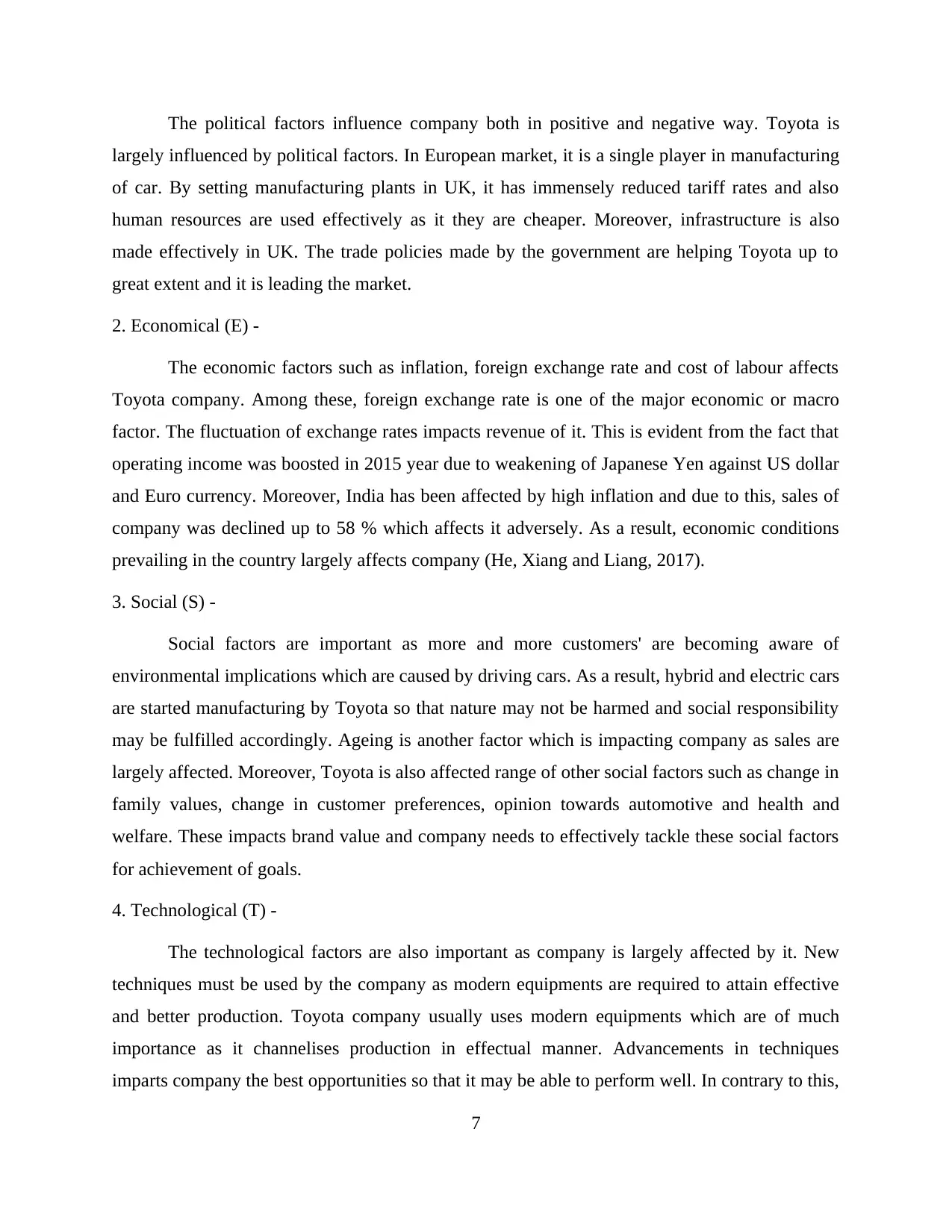
The political factors influence company both in positive and negative way. Toyota is
largely influenced by political factors. In European market, it is a single player in manufacturing
of car. By setting manufacturing plants in UK, it has immensely reduced tariff rates and also
human resources are used effectively as it they are cheaper. Moreover, infrastructure is also
made effectively in UK. The trade policies made by the government are helping Toyota up to
great extent and it is leading the market.
2. Economical (E) -
The economic factors such as inflation, foreign exchange rate and cost of labour affects
Toyota company. Among these, foreign exchange rate is one of the major economic or macro
factor. The fluctuation of exchange rates impacts revenue of it. This is evident from the fact that
operating income was boosted in 2015 year due to weakening of Japanese Yen against US dollar
and Euro currency. Moreover, India has been affected by high inflation and due to this, sales of
company was declined up to 58 % which affects it adversely. As a result, economic conditions
prevailing in the country largely affects company (He, Xiang and Liang, 2017).
3. Social (S) -
Social factors are important as more and more customers' are becoming aware of
environmental implications which are caused by driving cars. As a result, hybrid and electric cars
are started manufacturing by Toyota so that nature may not be harmed and social responsibility
may be fulfilled accordingly. Ageing is another factor which is impacting company as sales are
largely affected. Moreover, Toyota is also affected range of other social factors such as change in
family values, change in customer preferences, opinion towards automotive and health and
welfare. These impacts brand value and company needs to effectively tackle these social factors
for achievement of goals.
4. Technological (T) -
The technological factors are also important as company is largely affected by it. New
techniques must be used by the company as modern equipments are required to attain effective
and better production. Toyota company usually uses modern equipments which are of much
importance as it channelises production in effectual manner. Advancements in techniques
imparts company the best opportunities so that it may be able to perform well. In contrary to this,
7
largely influenced by political factors. In European market, it is a single player in manufacturing
of car. By setting manufacturing plants in UK, it has immensely reduced tariff rates and also
human resources are used effectively as it they are cheaper. Moreover, infrastructure is also
made effectively in UK. The trade policies made by the government are helping Toyota up to
great extent and it is leading the market.
2. Economical (E) -
The economic factors such as inflation, foreign exchange rate and cost of labour affects
Toyota company. Among these, foreign exchange rate is one of the major economic or macro
factor. The fluctuation of exchange rates impacts revenue of it. This is evident from the fact that
operating income was boosted in 2015 year due to weakening of Japanese Yen against US dollar
and Euro currency. Moreover, India has been affected by high inflation and due to this, sales of
company was declined up to 58 % which affects it adversely. As a result, economic conditions
prevailing in the country largely affects company (He, Xiang and Liang, 2017).
3. Social (S) -
Social factors are important as more and more customers' are becoming aware of
environmental implications which are caused by driving cars. As a result, hybrid and electric cars
are started manufacturing by Toyota so that nature may not be harmed and social responsibility
may be fulfilled accordingly. Ageing is another factor which is impacting company as sales are
largely affected. Moreover, Toyota is also affected range of other social factors such as change in
family values, change in customer preferences, opinion towards automotive and health and
welfare. These impacts brand value and company needs to effectively tackle these social factors
for achievement of goals.
4. Technological (T) -
The technological factors are also important as company is largely affected by it. New
techniques must be used by the company as modern equipments are required to attain effective
and better production. Toyota company usually uses modern equipments which are of much
importance as it channelises production in effectual manner. Advancements in techniques
imparts company the best opportunities so that it may be able to perform well. In contrary to this,
7
⊘ This is a preview!⊘
Do you want full access?
Subscribe today to unlock all pages.

Trusted by 1+ million students worldwide
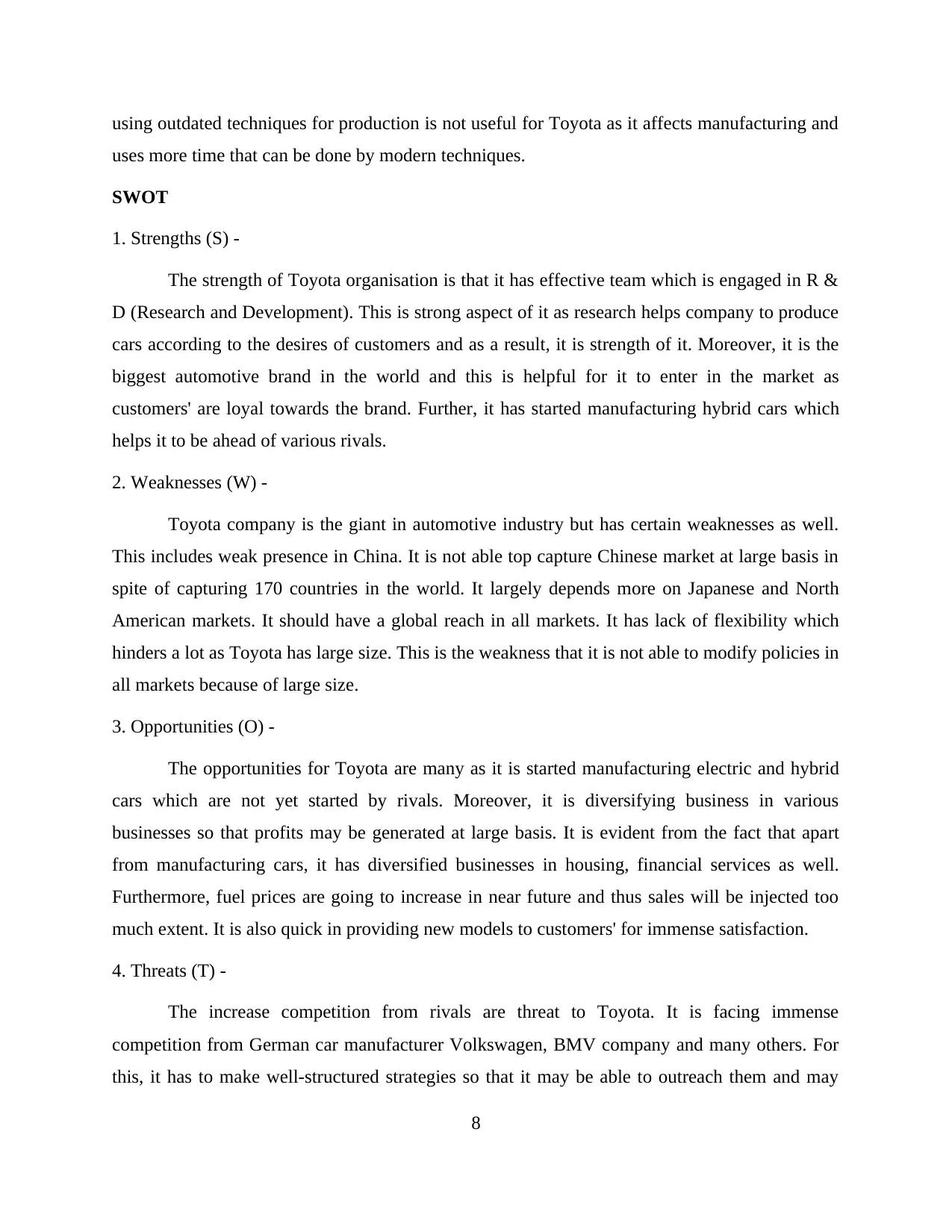
using outdated techniques for production is not useful for Toyota as it affects manufacturing and
uses more time that can be done by modern techniques.
SWOT
1. Strengths (S) -
The strength of Toyota organisation is that it has effective team which is engaged in R &
D (Research and Development). This is strong aspect of it as research helps company to produce
cars according to the desires of customers and as a result, it is strength of it. Moreover, it is the
biggest automotive brand in the world and this is helpful for it to enter in the market as
customers' are loyal towards the brand. Further, it has started manufacturing hybrid cars which
helps it to be ahead of various rivals.
2. Weaknesses (W) -
Toyota company is the giant in automotive industry but has certain weaknesses as well.
This includes weak presence in China. It is not able top capture Chinese market at large basis in
spite of capturing 170 countries in the world. It largely depends more on Japanese and North
American markets. It should have a global reach in all markets. It has lack of flexibility which
hinders a lot as Toyota has large size. This is the weakness that it is not able to modify policies in
all markets because of large size.
3. Opportunities (O) -
The opportunities for Toyota are many as it is started manufacturing electric and hybrid
cars which are not yet started by rivals. Moreover, it is diversifying business in various
businesses so that profits may be generated at large basis. It is evident from the fact that apart
from manufacturing cars, it has diversified businesses in housing, financial services as well.
Furthermore, fuel prices are going to increase in near future and thus sales will be injected too
much extent. It is also quick in providing new models to customers' for immense satisfaction.
4. Threats (T) -
The increase competition from rivals are threat to Toyota. It is facing immense
competition from German car manufacturer Volkswagen, BMV company and many others. For
this, it has to make well-structured strategies so that it may be able to outreach them and may
8
uses more time that can be done by modern techniques.
SWOT
1. Strengths (S) -
The strength of Toyota organisation is that it has effective team which is engaged in R &
D (Research and Development). This is strong aspect of it as research helps company to produce
cars according to the desires of customers and as a result, it is strength of it. Moreover, it is the
biggest automotive brand in the world and this is helpful for it to enter in the market as
customers' are loyal towards the brand. Further, it has started manufacturing hybrid cars which
helps it to be ahead of various rivals.
2. Weaknesses (W) -
Toyota company is the giant in automotive industry but has certain weaknesses as well.
This includes weak presence in China. It is not able top capture Chinese market at large basis in
spite of capturing 170 countries in the world. It largely depends more on Japanese and North
American markets. It should have a global reach in all markets. It has lack of flexibility which
hinders a lot as Toyota has large size. This is the weakness that it is not able to modify policies in
all markets because of large size.
3. Opportunities (O) -
The opportunities for Toyota are many as it is started manufacturing electric and hybrid
cars which are not yet started by rivals. Moreover, it is diversifying business in various
businesses so that profits may be generated at large basis. It is evident from the fact that apart
from manufacturing cars, it has diversified businesses in housing, financial services as well.
Furthermore, fuel prices are going to increase in near future and thus sales will be injected too
much extent. It is also quick in providing new models to customers' for immense satisfaction.
4. Threats (T) -
The increase competition from rivals are threat to Toyota. It is facing immense
competition from German car manufacturer Volkswagen, BMV company and many others. For
this, it has to make well-structured strategies so that it may be able to outreach them and may
8
Paraphrase This Document
Need a fresh take? Get an instant paraphrase of this document with our AI Paraphraser

dominate the market. Government regulations are subjected to threats which largely affects
company as it operates in different markets and various nations have several regulations which
has to be followed to function effectively. Innovative goods are supplied by various companies
and as such, Toyota has to match them in order to capture the market.
CONCLUSION
Hereby it can be concluded that Toyota company is earning good profits in 2016 and
2017 financial years. It has remarkable capital structure as well. Financial ratios are interpreted
which reveals that it has good liquidity, profitability and solvency position. It is also earning
good revenue in the emerging markets. Moreover, it is way ahead in manufacturing hybrid cars
against its rivals in the automotive industry. It is performing well in the overall market as well.
9
company as it operates in different markets and various nations have several regulations which
has to be followed to function effectively. Innovative goods are supplied by various companies
and as such, Toyota has to match them in order to capture the market.
CONCLUSION
Hereby it can be concluded that Toyota company is earning good profits in 2016 and
2017 financial years. It has remarkable capital structure as well. Financial ratios are interpreted
which reveals that it has good liquidity, profitability and solvency position. It is also earning
good revenue in the emerging markets. Moreover, it is way ahead in manufacturing hybrid cars
against its rivals in the automotive industry. It is performing well in the overall market as well.
9

REFERENCES
Books and Journals
Cândido, L. F. and Neto, J. D. P. B., 2017. FEATURES, ROLES AND PROCESSES OF
PERFORMANCE MEASUREMENT IN LEAN CONSTRUCTION.
Charter, M. ed., 2017. Greener marketing: A responsible approach to business. Routledge.
Demos, M. and et.al., 2017. Diagnostic Yield And Treatment Impact Of Targeted Exome
Sequencing In Early-Onset Epilepsy. bioRxiv, p.139329.
He, S., Xiang, Z. and Liang, Y., 2017. SWOT analysis of tourist industry and the strategies of
precisely targeted poverty alleviation-taking Baojing County of Hunan Province as an
example. Journal of Southwest University for Nationalities-Natural Science Edition. 43(2).
pp.209-214.
Jeon, S. and et.al., 2017. A Study on Development Trends of Chinese Game Technology.
TECHART: Journal of Arts and Imaging Science. 4(3). pp.27-30.
Jin, Z., Yang, H. L. and Yin, G., 2017. A numerical approach to optimal dividend policies with
capital injections and transaction costs. Acta Mathematicae Applicatae Sinica, English
Series. 33(1). pp.221-238.
Newman, N. and et.al., 2017. Reuters Institute Digital News Report 2017.
Sattar, A. and et.al., 2017. Do Dividend Payout Ratio Drive the Profitability of a Firm: A Case of
Energy and Textile Sector of Pakistan?. In Advances in Applied Economic Research (pp.
591-597). Springer, Cham.
Sokolov, A. A. and Arkin, P. A., 2017, May. Planning of a project for development and
introduction of an automated industrial engineering. In Soft Computing and Measurements
(SCM), 2017 XX IEEE International Conference on (pp. 765-767). IEEE.
Tsuji, C., 2017. A Non-linear Estimation of the Capital Asset Pricing Model: The Case of
Japanese Automobile Industry Firms. Applied Finance and Accounting. 3(2). pp.20-26.
Online
Dudovskiy, 2016 Toyota SWOT Analysis [Online] Available Through: <https://research-
methodology.net/toyota-swot-analysis/>
10
Books and Journals
Cândido, L. F. and Neto, J. D. P. B., 2017. FEATURES, ROLES AND PROCESSES OF
PERFORMANCE MEASUREMENT IN LEAN CONSTRUCTION.
Charter, M. ed., 2017. Greener marketing: A responsible approach to business. Routledge.
Demos, M. and et.al., 2017. Diagnostic Yield And Treatment Impact Of Targeted Exome
Sequencing In Early-Onset Epilepsy. bioRxiv, p.139329.
He, S., Xiang, Z. and Liang, Y., 2017. SWOT analysis of tourist industry and the strategies of
precisely targeted poverty alleviation-taking Baojing County of Hunan Province as an
example. Journal of Southwest University for Nationalities-Natural Science Edition. 43(2).
pp.209-214.
Jeon, S. and et.al., 2017. A Study on Development Trends of Chinese Game Technology.
TECHART: Journal of Arts and Imaging Science. 4(3). pp.27-30.
Jin, Z., Yang, H. L. and Yin, G., 2017. A numerical approach to optimal dividend policies with
capital injections and transaction costs. Acta Mathematicae Applicatae Sinica, English
Series. 33(1). pp.221-238.
Newman, N. and et.al., 2017. Reuters Institute Digital News Report 2017.
Sattar, A. and et.al., 2017. Do Dividend Payout Ratio Drive the Profitability of a Firm: A Case of
Energy and Textile Sector of Pakistan?. In Advances in Applied Economic Research (pp.
591-597). Springer, Cham.
Sokolov, A. A. and Arkin, P. A., 2017, May. Planning of a project for development and
introduction of an automated industrial engineering. In Soft Computing and Measurements
(SCM), 2017 XX IEEE International Conference on (pp. 765-767). IEEE.
Tsuji, C., 2017. A Non-linear Estimation of the Capital Asset Pricing Model: The Case of
Japanese Automobile Industry Firms. Applied Finance and Accounting. 3(2). pp.20-26.
Online
Dudovskiy, 2016 Toyota SWOT Analysis [Online] Available Through: <https://research-
methodology.net/toyota-swot-analysis/>
10
⊘ This is a preview!⊘
Do you want full access?
Subscribe today to unlock all pages.

Trusted by 1+ million students worldwide
1 out of 12
Related Documents
Your All-in-One AI-Powered Toolkit for Academic Success.
+13062052269
info@desklib.com
Available 24*7 on WhatsApp / Email
![[object Object]](/_next/static/media/star-bottom.7253800d.svg)
Unlock your academic potential
Copyright © 2020–2025 A2Z Services. All Rights Reserved. Developed and managed by ZUCOL.




